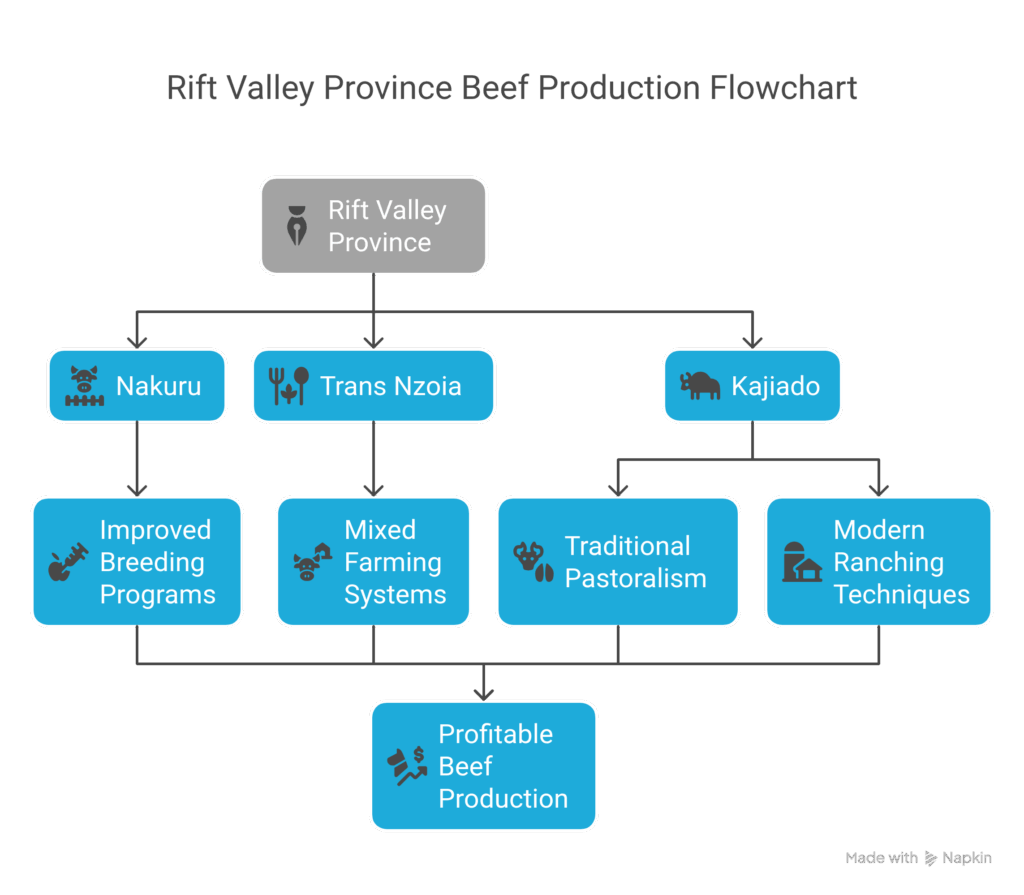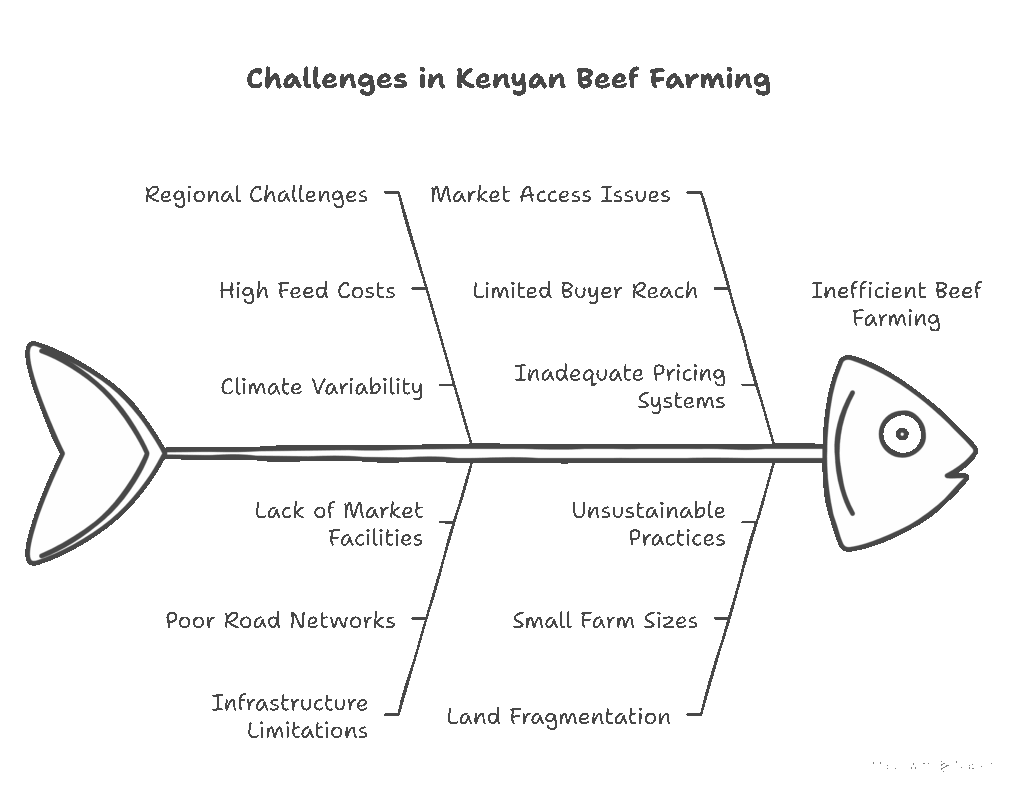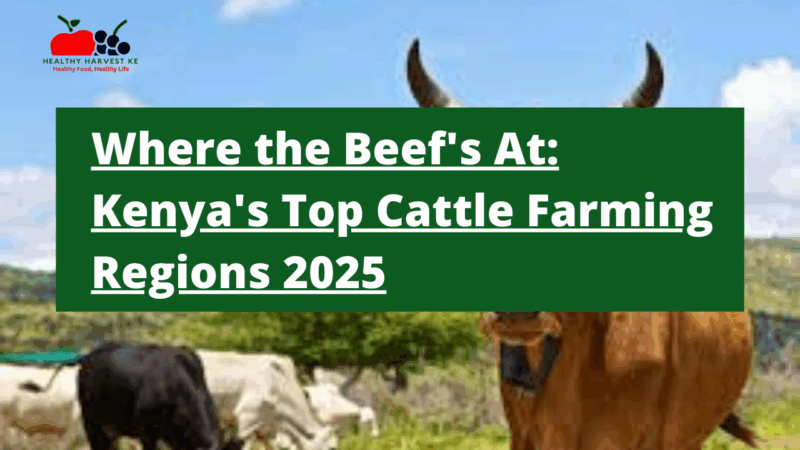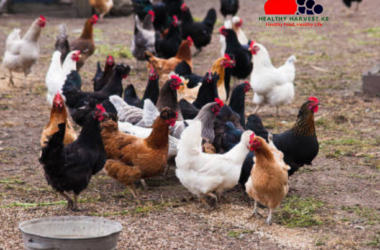Let’s talk beef. Not the drama kind, but the actual meat that 80% of Kenyans can’t get enough of. Kenya’s beef industry isn’t just big business—it’s the backbone of the country’s agricultural economy, contributing a whopping 36% to agricultural GDP. But where exactly are these cattle roaming, and who’s raising them? Let’s break down the hotspots where Kenyan beef farming thrives.
The Heavy Hitters: Rift Valley Province
When it comes to commercial beef operations in Kenya, the Rift Valley Province takes the crown. This region isn’t playing around—it hosts some of the most productive beef farming enterprises in the country.
Specific districts crushing the beef game include:
- Nakuru: Known for larger commercial ranches with improved breeding programs
- Trans Nzoia: Home to mixed farming systems where cattle complement crop production
- Kajiado: Where traditional Maasai pastoralism meets modern ranching techniques
These areas hit the sweet spot of suitable conditions—decent rainfall patterns, expansive grasslands, and access to water sources that keep beef production profitable. The region’s blend of traditional pastoralism and modern ranching creates a unique beef farming landscape that’s adapting to changing market demands.

Coastal Champions: Coast Province
Don’t sleep on the Coast Province when talking about Kenya’s beef scene. This region brings serious heat to the industry with operations concentrated in:
- Kilifi District: Where coastal ranching operations thrive despite higher temperatures
- Kwale District: Home to innovative beef farming approaches adapted to coastal conditions
The coastal region has made significant strides in recent years, particularly with the establishment of disease-free zones that have opened doors to export markets like Mauritius. These zones represent game-changing progress for Kenya’s beef industry, creating opportunities beyond domestic markets.
The Backbone: Arid and Semi-Arid Lands (ASALs)
Let’s get real—you can’t talk about Kenyan beef without showing love to the ASALs. These regions are home to approximately 36% of Kenya’s population and form the true backbone of traditional beef production.
Key ASAL regions include:
- Samburu County: Where traditional pastoralism remains the dominant production system, with new infrastructure developments like modern abattoirs under construction
- Northern Kenya regions: Including Turkana, Marsabit, and Wajir, where vast lands support extensive grazing systems
What makes these areas unique? The resilience, man. Traditional pastoralists here have mastered the art of raising cattle under harsh conditions that would make other farming systems tap out. These communities have centuries of knowledge about moving herds to find water and pasture—expertise that’s becoming even more valuable as climate change intensifies.
The Innovation Zones: Mixed Farming Regions
Not all beef comes from sprawling ranches or nomadic herds. Some of Kenya’s most interesting beef farming happens in mixed farming zones where cattle production integrates with crop farming:
- Central Kenya highlands: Where dairy-beef systems capitalize on male calves from dairy operations
- Western Kenya: Home to smallholder systems that maximize limited land through intensive management
These regions are where you’ll find the up-and-coming Oramat cooperative model—a fresh approach that blends traditional cattle keeping with modern methods. This two-tier cooperative has turned over Ksh 64 million in just four years by purchasing steers directly from communities and fattening cattle on behalf of community members.
By the Numbers: Kenya’s Beef Distribution Map
Let’s drop some stats to show you the big picture of Kenya’s beef industry:
| Region | Approximate Cattle Population | Production System | Key Advantages |
|---|---|---|---|
| Rift Valley | 40% of national herd | Commercial ranching & pastoralism | Better infrastructure & market access |
| ASALs | 50% of national herd | Traditional pastoralism | Vast grazing lands & indigenous knowledge |
| Coast Province | 5% of national herd | Ranching & mixed systems | Export potential through disease-free zones |
| Mixed Farming Zones | 5% of national herd | Integrated crop-livestock | Efficient resource use & value addition |
With 23.5 million head of cattle (according to Statista) or 15.8 million (per CABI)—depending on which source you trust—there’s serious beef business happening across these regions.
What’s Working: Success Stories Across Regions
Each beef farming region in Kenya has its own success stories that highlight what’s possible when traditional knowledge meets modern approaches:
Rift Valley Pioneers
In Nakuru and surrounding areas, ranchers are killing it with strategic crossbreeding programs. By crossing indigenous Boran and Sahiwal cattle with exotic breeds like Hereford and Charolais, they’re creating animals that can handle local conditions while growing faster and producing more meat. These operations focus on premium feeding approaches, including supplementing natural pastures with protein-rich feeds like lucerne during finishing phases.
Coastal Innovations
The establishment of disease-free zones in coastal areas has been a complete game-changer. These zones have allowed Kenya to begin exporting livestock to markets that were previously off-limits, creating premium price opportunities for farmers who can meet international standards.
ASAL Adaptations
The Oramat cooperative model deserves another shoutout here. By introducing microchip tagging for animal identification, systematic weight measurement, and transparent payment systems, they’ve shown how technology can enhance traditional systems without replacing them. This cooperative returns 80% of value gain to original cattle owners after the six-month fattening period—creating real wealth in communities that have been cattle keepers for generations.
Challenges Still on the Table
Let’s keep it 100—beef farming in Kenya isn’t all smooth sailing. Each region faces specific challenges:
- Rift Valley: High feed costs and disease outbreaks can crush profit margins
- ASALs: Climate variability hits these regions hardest, with droughts becoming more frequent
- Coast Province: Infrastructure limitations and market access issues persist
- Mixed Farming Zones: Land fragmentation threatens sustainable production
Across all regions, inadequate infrastructure remains a serious pain point. Many livestock markets lack basic facilities like weighing systems, which means pricing happens through eyeballing animals rather than objective measures—not exactly cutting-edge business practice.

The Future: Where Kenya’s Beef Industry Is Headed
The potential for growth is massive. FAO projections suggest Kenya’s cattle population will jump by 90% by 2050, while beef production rises to approximately 2,000 tonnes. With Kenya’s population expected to nearly double to 96 million by 2050 (with half living in urban areas), demand for beef isn’t slowing down.
The most exciting developments are happening at the intersection of traditional knowledge and modern tech. Forward-thinking producers are adopting improved breeding programs, better disease management, and strategic feeding approaches while maintaining the resilience that makes Kenyan beef farming unique.
Should You Get Into the Beef Game?
If you’re considering beef farming in Kenya, location matters—a lot. Here’s the quick breakdown:
- For commercial ranching: The Rift Valley offers established infrastructure and favorable conditions
- For traditional systems: ASALs provide vast grazing lands but require deep knowledge of pastoralism
- For export-oriented production: Coastal regions with disease-free zones offer premium market access
- For integrated farming: Mixed farming zones allow for diversified income streams
Regardless of location, successful beef farming in Kenya means selecting appropriate breeds (like the hardy Boran and Sahiwal), implementing solid feeding and nutrition management, and staying on top of disease prevention.
The Bottom Line
Kenya’s beef farming landscape is as diverse as the country itself, with each region offering unique advantages and challenges. From the vast pasturelands of the ASALs to the commercial ranches of the Rift Valley, from the export-oriented coastal regions to the integrated systems of mixed farming zones—beef production is woven into the fabric of Kenya’s agricultural economy.
With growing demand, technological innovation, and increasing investment, Kenya’s beef farming regions are positioned for significant growth. The secret sauce for future success? Blending the resilience of traditional systems with the efficiency of modern approaches—creating a beef industry that’s both productive and sustainable.
What’s your take on Kenya’s beef farming regions? Have you visited any of these areas or tried beef from different parts of the country? Drop a comment below—I’d love to hear your experiences.










